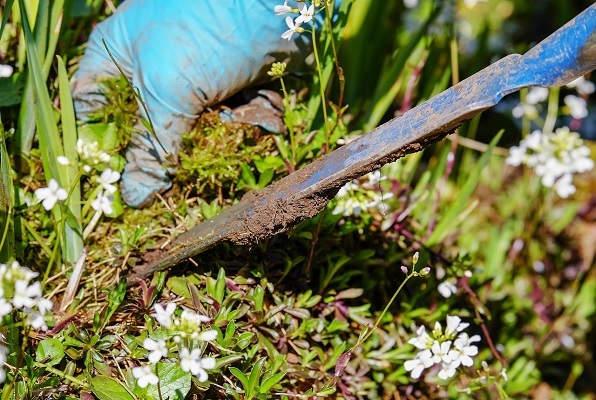Uncategorized
How to Get Rid of Weeds and Keep Them From Coming Back

Getting rid of weeds is one of the most frustrating jobs any gardener has to face. But it can be a breeze if you can learn to get them out properly and keep them away from coming back!
Weeds are resilient plants that spread through seeds, roots and runners. They are also often able to survive in areas where there is little water.
Salt
Salt can be an effective way to kill weeds in the garden. It is easy to use and is also environmentally friendly. However, it should be used cautiously as it is toxic to the soil and can damage surrounding vegetation.
It can take from several days to weeks for weeds to die when salt is applied. It can be due to several factors, including the concentration of the salt solution, weed size and rain conditions.
Rock salt is a common herbicide that is inexpensive and easy to access. It is also less corrosive to plants than table salt.
In addition, salt is non-toxic to pets and children. It is often preferred over other weed-killing methods, like burning.
When you mix salt with water, it is more effective as a weed killer. This solution can spray weeds or sprinkle them on the ground.
For best results, it is recommended to use a mixture of salt and water in a ratio of 3:1. You should also stir well so that the salt crystals dissolve properly.
Vinegar
The most popular vinegar for weeding is standard white vinegar with a 5% acidity. This concentration works best for new weeds that have appeared in the last two weeks, while a horticultural vinegar with 30-45% acidity will eliminate more mature weeds.
For weeds growing for more than a week, you can mix a solution of equal parts vinegar and salt. It will help the acetic acid in the vinegar burn and dry out the weeds, which will kill them.
When applying this type of weed-killing solution, you will want to use a spray bottle with a nozzle that releases the solution as a stream.
Using vinegar as a weed killer will also leave your soil acidic, making it more difficult for weeds to grow. It will be especially helpful to have hardscapes such as driveways or brick or gravel patios.
If you are using a strong acetic acid solution, it is important to take the proper precautions and wear protective clothing and eyewear.
Boiling Water
Boiling water is a great way to eliminate weeds without adding chemicals to the soil. It can also help kill invasive broad-leaf weeds like white clover and dandelions.
The most important thing to remember when using boiling water is that it will destroy any other plants you come into contact with. It means you should only use this method on weeds completely isolated to the scalding hot water.
Luckily, there are a few simple steps that you can follow to eliminate weeds using this method successfully. To begin, you’ll want to bring a kettle or large pot of water to a boil on the stove or an outside burner. Once the water has reached scalding hot, you’ll want to use oven mitts to carry it outside and pour it on your weeded area.
Another benefit of this method is that it can destroy the roots of invasive broad-leaf weeds. It will ensure that you don’t have to worry about them re-growing in the future.
It is a very efficient and cost-effective method of killing weeds. It also doesn’t add harmful chemicals to the soil or the air, making it a good option for people who don’t want to risk using hazardous herbicides on their property.
While it’s possible to kill weeds with boiling water permanently, it takes multiple applications to see the best results. It can take several days for the hot water to travel down to the weed’s root system.
Flamethrower
Using a flamethrower is a natural way to get rid of weeds without using chemical-based herbicides, but it is important to know how to use it correctly and what kind of weeds can be killed by this method. It is especially useful when removing weeds in crevices, like sidewalk cracks or pathway areas.
Flame weeding works best for weeds a few inches in height or less. These weeds will quickly die once the flame hits them. If a weed is much bigger, it can take several flamings to kill it.
Flaming is effective for small, annual weeds but not for perennial weeds, such as crabgrass and clover, which have extensive underground root systems from which new plants can sprout. In addition, flaming is not an effective weed control method for areas that have been recently seeded.
While a flamethrower can be quite effective, it should not be used in areas where there is a high risk of starting a fire. Check Weed control in Calgary or your local fire department for regulations, and be careful when flaming around houses, cars, fences and other flammable objects.
-
Blog1 year ago
MyCSULB: Login to CSULB Student and Employee Portal – MyCSULB 2023
-
Android App3 years ago
Cqatest App What is It
-
Android1 year ago
What Is content://com.android.browser.home/ All About in 2023? Set Up content com android browser home
-
Software2 years ago
A Guide For Better Cybersecurity & Data Protection For Your Devices
-
Latest News2 years ago
Soap2day Similar Sites And Alternatives To Watch Free Movies
-
Android2 years ago
What is OMACP And How To Remove It? Easy Guide OMACP 2022
-
Android3 years ago
What is org.codeaurora.snapcam?
-
Business2 years ago
Know Your Business (KYB) Process – Critical Component For Partnerships





















